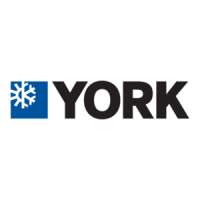JOHNSON CONTROLS
31
FORM 150.67-NM2
ISSUE DATE: 01/31/2019
4
To ensure warranty coverage, this equip-
ment must be commissioned and serviced
by an authorized YORK service mechanic
or a qualied service person experienced
in chiller installation. Installation must
comply with all applicable codes, par-
ticularly in regard to electrical wiring
and other safety elements such as relief
valves, HP cutout settings, design working
pressures, and ventilation requirements
consistent with the amount and type of
refrigerant charge.
Lethal voltages exist within the control
panels. Before servicing, open and tag
all disconnect switches.
INSTALLATION CHECKLIST
The following items, 1 through 5, must be checked be-
fore placing the units in operation.
1. Inspect the unit for shipping damage.
2. Rig unit using spreader bars.
3. Open the unit only to install water piping sys-
tem. Do not remove protective covers from water
connections until piping is ready for attachment.
Check water piping to ensure cleanliness.
4. Pipe unit using good piping practice (see ASHRAE
handbook section 215 and 195).
5. Check to see that the unit is installed and operated
within limitations (Refer to Operational Limita-
tions on page 39).
The following pages outline detailed procedures to be
followed to install and start-up the chiller.
HANDLING
These units are shipped as completely assembled units
containing full operating charge, and care should be
taken to avoid damage due to rough handling.
INSPECTION
Immediately upon receiving the unit, it should be in-
spected for possible damage which may have occurred
during transit. If damage is evident, it should be noted
in the carrier’s freight bill. A written request for inspec-
tion by the carrier’s agent should be made at once. See
“Instruction” manual, Form 50.15-NM for more infor-
mation and details.
SECTION 4 – INSTALLATION
LOCATION AND CLEARANCES
These units are designed for outdoor installations on
ground level, rooftop, or beside a building. Location
should be selected for minimum sun exposure and to
insure adequate supply of fresh air for the condenser.
The units must be installed with sufficient clearances
for air entrance to the condenser coil, for air discharge
away from the condenser, and for servicing access.
In installations where winter operation is intended and
snow accumulations are expected, additional height
must be provided to ensure normal condenser air flow.
Clearances are listed under “Notes” in the “Dimen-
sions on page 70” section.
Foundation
The unit should be mounted on a flat and level founda-
tion, floor, or rooftop capable of supporting the entire
operating weight of the equipment. See PHYSICAL
DATA for operating weight. If the unit is elevated be-
yond the normal reach of service personnel, a suitable
catwalk must be capable of supporting service person-
nel, their equipment, and the compressors.
Ground Level Locations
It is important that the units be installed on a substan-
tial base that will not settle. A one piece concrete slab
with footers extended below the frost line is highly rec-
ommended. Additionally, the slab should not be tied to
the main building foundations as noise and vibration
may be transmitted. Mounting holes are provided in
the steel channel for bolting the unit to its foundation
(see Dimensions on page 70).
For ground level installations, precautions should be
taken to protect the unit from tampering by or injury to
unauthorized persons. Screws and/or latches on access
panels will prevent casual tampering. However, further
safety precautions such as a fenced-in enclosure or
locking devices on the panels may be advisable.
Rooftop Locations
Choose a spot with adequate structural strength to
safely support the entire weight of the unit and service
personnel. Care must be taken not to damage the roof.
Consult the building contractor or architect if the roof is
bonded. Roof installations should have wooden beams
(treated to reduce deterioration), cork, rubber, or vibra-
tion isolators under the base to minimize vibration.

